Here is my entry for the second Lasang Pinoy food blogging event which was started by Karen and Stef and currently hosted by moi. ;)
The start of the rainy season in the Philippines (around June) usually coincide with the start of school. So the beginning of each bring back jaunted memories of smell of new pencils and erasers (rubber), smell of the plasticky-rubbery new umbrellas, bags and shoes, wet grass, newly wet earth, cool humid afternoons.
In a way, the rains are welcome respite from the intense heat and humidity of the preceding March-April. Though at the back of the mind is that wariness of the typhoons that are sure to come anytime to wreak havoc on people's lives and properties. For kids, typhoons are greeted with joy - school's closed, no classes! They bathe in the rain, some even in flood waters (not safe). But for me it comes with that snug feeling of warmth with all the family forced by the weather to be inside the house. My grandparent's house in Cavite where I grew up had those sliding capiz windows. They’re not water or windproof so come typhoons, we grandkids with our aunts race around the house stuffing edges and joints of windows with rags to prevent the rainwater from coming in. While my lolo (grandpa) goes out with these big abaca ropes to tie down the haligi (pillars) of the house and other trees around their yard.
After all the chores are done, since there was usually no electricity (so no TV to watch), my aunts would take out playing cards, sungka, checker boards, chess boards, etc. to keep us occupied. It was great fun really with us learning solitaires, pekwa, pares-pares, 21, and other card games. When it gets a bit dark, someone will regale us with ghost stories or listen to some scary drama shows on the radio. This will cause us kids to all stick together no matter where one goes - even in the toilet! Hahaha. ;)

As for the food, since there was no market, all our food are simple and lots of times comes from the 'victims' of the typhoon. So we often had the crops of those uprooted and damaged by the wind - kamote (sweet potatoes), saba banana, butuhan banana, balinghoy (kamoteng kahoy, cassava), kangkong (tung choi), talbos ng kamote (sweet potato tops), etc. These are cooked simply - meaning boiled or steamed - then eaten hot. Sometimes when the storm lasts for several days and we've had enough of boiled this and boiled that. My grandma would grate some balinghoy and steam it then serve with freshly grated coconut sprinkled with sugar. We call this 'kalangkang'. The combination of the soft, slightly gelatinous cassava and sweet grated coconut is simply divine! Sometimes the simple things in life are the best.
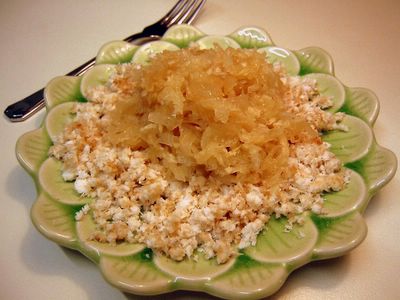 Kalangkang
Kalangkang
finely grated cassava
freshly grated coconut
sugar (brown or white)
- (It's best to grate the cassava finely to have shorter cooking time.) Put the grated cassava on a very lightly greased bowl or plate.
- Place bowl in a steamer and cook on high steam for about 30 minutes or until cassava is translucent and soft.
- Serve hot or warm with grated coconut sprinkled with sugar.
Lasang Pinoy 2
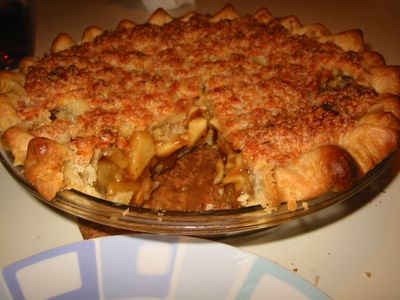 The glut of apples in autumn time is very much welcome to my son, J1, who adores apples in baked products. May it be pies, pastry, bread, or cakes. For sometime, the two of us have been trying out different versions of classic apple pies (of course with me slaving away while he does the tasting) to see which ones will have the honor of staying in our family recipe list.
The glut of apples in autumn time is very much welcome to my son, J1, who adores apples in baked products. May it be pies, pastry, bread, or cakes. For sometime, the two of us have been trying out different versions of classic apple pies (of course with me slaving away while he does the tasting) to see which ones will have the honor of staying in our family recipe list.
One of them is this pie with a streusel topping. 'Streusel' according to the Joy of Baking glossary, is a type of cake or pastry topping, German in origin, and has a base of flour, butter, and sugar in which spices, nuts, and other ingredients are added. I adapted this from my beloved battered Let's Cook with Nora by Nora Daza.
I remember well the second time I baked this, I was so distracted with the things going on in the kitchen that I forgot to add flour to the sugar mixture used to toss the apples with. It turned out like an apple pie soup! Crusts at top and bottom were fine but the middle was so wet I was ladling it out when serving. :LOL: Then another time, I forgot to put milk with the topping ingredients. Whatever it was, seems this pie always get shortchanged. ;) So this time I banished all the kids from the kitchen and had a run down of the ingredients to make sure everything is in there. The only thing that I think I have to tweak is the cooking time since even after 40 minutes some of the apple pieces were not fully cooked (not that we mind ...) hence I put in 55 minutes in the recipe below.
About our taste preference, we don't like our apple pies too tart and not too sweet as well with just a tad bit of saltiness in it. This one has that kinda savoury-sweet tang in the topping courtesy of the cheese. The sugar in the filling was reduced a lot and the bottom crust is oh so flaky and buttery. Nice.
Apple Streusel Pie
*Crust:
85 g [1/3 cup] butter - chilled
1 1/4 cup flour
1/4 tsp fine salt
2-3 Tbsp cold water
* Filling:
4 cups roughly chopped baking apples (Golden Delicious, Jonagold, Cox, etc.) - cored and peeled first
1/3 cup firmly packed brown sugar
1/4 tsp nutmeg
3/4 tsp cinnamon
1/8 tsp salt
2 Tbsp flour
*Topping:
1/2 cup flour
1/3 cup golden granulated sugar
2 Tbsp butter
1 cup coarsely grated cheese
2 Tbsp milk

- Preheat oven to 180°C/fan 160°C/350°F/gas mark 4.
- For the crust:
- Put the flour and butter in a bowl.
- Cut the butter into the flour with a pastry cutter or two butter knives until mixture is into a crumbly state.
- Sprinkle enough water and toss until you can gather the dough into a ball. Press, turn and gently knead to just about bring it together until the doughball is smooth and the texture uniform. Caution: do not over knead of it will become inelastic and stiff.
- Wrap or put in a plastic bag and chill in the fridge for 30 minutes.
- On a clean, floured surface or between greaseproof paper and cling film, roll flat evenly with a rolling pin into a circle shape with a diameter of about 11 inches.
- Turn out dough on a 9-inch pie plate. Trim edge until you have about 1 inch overhanging all around.
- Tuck the overhang under and flute the sides decoratively with a fork or with fingers.
- Prick crust all over with fork.
- For the filling:
- Combine all ingredients except the apple in a container and mix well.
- Toss the chopped apple in the spice mixture.
- Put and arrange into the unbaked pie crust.
- For the topping:
- Combine sugar and flour in a bowl.
- Cut in butter with a pastry cutter or two butter knives until crumbly.
- Add in cheese and toss to combine.
- Sprinkle milk and mix well.
- Spread to cover top of apple mixture.
- Bake in oven for about 55 minutes. If the crust and topping is browning too much, coverly loosely with aluminum foil.
- Remove from oven and cool. Serve warm or cold.
 Disaster anyone? This was meant for the SHF 12 with a theme of custard but as you can see these Nanaimo Bars were not exactly a paragon of beauty. I don't know if I did anything wrong or there's something inherently flawed in the recipe itself. Mind you, it was only the middle custard part that didn't work. The base and topping were great but as you can see the middle layer is sooo gooey, it just collapses during cutting so I had to freeze it first *overnight*. Come morning, it was still gooey while the bottom and top were rock hard.
Disaster anyone? This was meant for the SHF 12 with a theme of custard but as you can see these Nanaimo Bars were not exactly a paragon of beauty. I don't know if I did anything wrong or there's something inherently flawed in the recipe itself. Mind you, it was only the middle custard part that didn't work. The base and topping were great but as you can see the middle layer is sooo gooey, it just collapses during cutting so I had to freeze it first *overnight*. Come morning, it was still gooey while the bottom and top were rock hard.
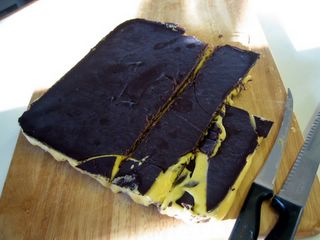
I tried hack it off with a variety of implements - bread knife, carving knife, chef's knife, etc. Could I have tried an axe? ;-p I tried warming the knives first but to no avail most of them still broke up though there were some little success but it's that darn custard that won't set !! Maybe I should have just served it on the side because the rest of it is absolutely delicious.
A little background on these rich delectable bar cookies (which I will not make again unless I come across a better technique or recipe for the custard), which were said to have originated in the town of Nanaimo in Vancouver, Canada. No one is certain on who originally came up with this recipe. But the same cannot be said of its deliciousness as it's certainly moreish minus the custard ;). The other thing going for this is the fact that it's a no-bake cookie bar. Sue Lawrence's cookbook Book of Baking is from where I adapted this mini disaster. :LOL:
In case you want to make yourself miserable ;) here's the recipe:
Nanaimo Bars
*Base:
100 g unsalted butter
55 g [heaping 1/4 cup] golden caster sugar (superfine)
5 Tbsp cocoa - sifted
1 large egg
1 tsp vanilla extract
140 g digestive biscuit (or graham crackers) - crushed
70 g [1 cup] dessicated coconut
70 g [1/2 cup] chopped walnuts
*Filling:
100 g unsalted butter - softened
5 Tbsp custard powder*
200 g [1 1/2 cup] golden icing sugar (confectioner's)- sifted
1 large egg
1 tsp vanilla extract
*Topping:
140 g dark chocolate
25 g unsalted butter
1 Tbsp golden caster sugar (superfine)
- Grease and line a 9-inch square baking pan.
- For the base:
- Put the butter, sugar, cocoa, egg, and vanilla in a heatproof bowl and set over a saucepan of simmering water.
- Melt the mixture while stirring constantly.
- When it becomes smooth and slightly thick, remove from heat.
- Add in the biscuits and walnuts. Combine well.
- Press onto the prepared baking pan making sure to level it out. Chill in the fridge for at least 30 minutes.
- For the filling:
- In a heatproof bowl, beat together the softened butter and custard powder.
- Beat in the icing sugar, egg and vanilla.
- Place carefully on a larger bowl filled with hot (not boiling) water. Continue beating for about 1-2 minutes.
- Leave for 5-10 minutes in the bowl of hot water then beat again for another 1-2 minutes.
- Tip this over the chilled base. Chill in the fridge again for at least 30 minutes.
- For the topping:
- Put the butter, chocolate, and sugar in a heatproof bowl. Melt by putting the bowl over saucepan with simmering water. Stir until well combined and smooth.
- Tip on top of the chilled filling and base. Cool completely, then chill in the fridge for at least 30 minutes, then freeze for about 3 hours.
- Cut into squares while still cold and hard otherwise they will breakup.
Note: You can substitute vanilla pudding powder for the custard powder.
I was hoping to include this recipe of my maternal grandfather - Lolo Apeng - when I 'introduce' him in this blog. But circumstances in the other place where I blog caused me to post this to give an example of a Filipino dish that needs a boost in the presentation department. Anyhow, it tastes better than it looks - that I can assure you. The dish is something that my late grandfather came up with by combining the virtues of bistek, menudo, and afritada. Since he passed away already, nobody in my family knows why he named it Gisok. A mainstay in all of our family buffet table in Cavite, this is often requested by guests and relatives who have had it before. Our neighbors there even used to ask my lolo to prepare it for them. I hope you like this, too.
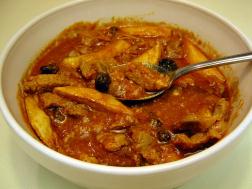 Gisok
Gisok
1 kg pork shoulder - cut into thick julienne
1 1/2 Tbsp oil
1/4 cup soy sauce
2 Tbsp lemon juice
1 Tbsp garlic - minced
1/2 cup chopped onion
1 cup chopped tomatoes
1/2 cup chopped chorizo (optional)
500 g passata (tomato sauce)
1 Tbsp soy sauce (optional)
1 Tbsp double concentrated tomato puree (tomato paste)
1/2 cup water
250 g pork or chicken liver - cut into thick julienne
salt to taste
1/2 cup grated cheddar cheese
2/3 cup raisins
500 g potatoes - julienned like French fries
- Cut the pork and liver separately into long and thin pieces about 1-2 inches long and about 1/4 - 1/2 inches wide.
- Combine the 1/4 cup soy sauce and lemon juice in a bowl. Taste and add more lemon or soy sauce according to preference. Marinate the pork in this mixture for at least 2-3 hours.
- In a large pot, heat the oil and saute the garlic, onion, then tomatoes. Add some salt.
- Add the pork including the marinade. Cook for a minute then cover the pot and simmer for about 5 minutes.
- Add the chorizo, passata, tomato puree, soy sauce (if using) and water. Bring to boil then simmer until meat is tender.
- While it's cooking, deep fry the potatoes. Set aside.
- Add the liver to the pot, cook for about 5 minutes.
- Add the raisins, cook for 3 minutes.
- Add the grated cheese and half of the potatoes. Cook for a further 2-3 minutes or until cheese is melted and well incorporated in the sauce.
- Remove from heat. Ladle into serving bowls and scatter some of the remaining potatoes on top.
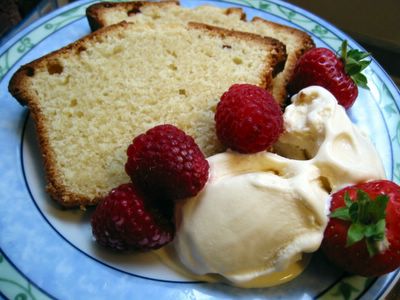 Originally popular in Victorian times, the Madeira cake was named after the wine that traditionally accompanied it. Nowadays, tea is the usual companion of this very buttery cake. This is very similar to the pound cake, with the main difference having to do with the addition of lemon zest and/or lemon juice for the former.
Originally popular in Victorian times, the Madeira cake was named after the wine that traditionally accompanied it. Nowadays, tea is the usual companion of this very buttery cake. This is very similar to the pound cake, with the main difference having to do with the addition of lemon zest and/or lemon juice for the former.
Surprisingly, it was not hard to do - no not at all. I think the key here (which I believe is the same with a lot of cakes) is to beat the butter and sugar very well until they're fluffy. The resulting aroma and taste of this moreish cake is really great. For me it is best serving it with fresh fruits and whipped cream or with vanilla ice cream. Again, I adapted the recipe in my current favourite Book of Baking by Sue Lawrence. I am sure I'm gonna make this again and again if only to indulge my kids. ;)
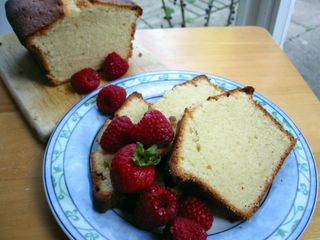 Madeira Cake
Madeira Cake
200 g unsalted butter - softened at room temperature
200 g [1 cup] golden caster sugar
3 large eggs
200 g [1 1/2 cup] self-raising flour - sifted
1/8 tsp fine salt
grated zest of 1 unwaxed lemon
juice of 1 lemon
- Preheat oven to 160°C/fan 140°C/325°F/gas mark 3. Grease and line bottom of a 2 lb (9 x 5-inch) loaf tin.
- Cream (beat) softened butter and sugar for about 5 minutes or until light and fluffy. Add in the lemon zest.
- Stir in 1 egg - mix, then a third of the flour and all of the salt - mix well until well combined. Repeat the procedure adding the egg one at a time followed by the flour always mixing well after each addition.
- Finally, add the lemon juice, combine well.
- Pour into the prepared baking pan making sure to level the top. Bake in oven for 45 minutes then lightly cover the top with foil and continue to bake for another 15 minutes or until a skewer poked in the middle comes out clean.
- Take out of the oven and cool in the baking pan for about 20 minutes then remove from the pan and cool completely on a wire rack. Best served sliced with some whipped cream or ice cream.
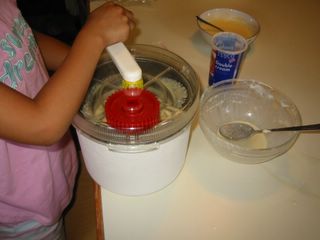 The last time we made this from scratch was more than 6 years ago. So long ago that when I took out our manual ice cream maker some white bits of it was slightly yellowing already! But I froze the base, made my youngest daughter J3 do the churning and it was still fine. This is great to make with the kids since they find it fun turning the crank at the same time making rich vanilla-y ice cream. It was yummy!
The last time we made this from scratch was more than 6 years ago. So long ago that when I took out our manual ice cream maker some white bits of it was slightly yellowing already! But I froze the base, made my youngest daughter J3 do the churning and it was still fine. This is great to make with the kids since they find it fun turning the crank at the same time making rich vanilla-y ice cream. It was yummy!
As for the cooking, the only thing I found hard - actually tricky - is the making of the custard. You have to set the heat to low and have to really constantly stir or you will have big lumps. I momentarily left the custard on the stove (just a few seconds) to attend to something urgent in the sink and believe me I got tiny lumpings in it. So I stirred like mad but it never went away. But when I combined it with the cream and churned it, not a sight of the even the tiniest lumps was seen. :sigh of relief: All well and good. :)
Vanilla Ice Cream
4 egg yolks
250 ml [1 cup] milk
250 ml [1 cup] double cream (heavy cream)
100 g [1/2 cup] golden caster sugar (superfine sugar)
1 1/2 tsp vanilla extract
- Combine the egg yolks with the sugar in a bowl, set aside.
- In a heavy bottomed saucepan, bring to boil the milk slowly. Once bubbles start to appear along the edges, pour about 1/4 cup of the hot milk in the egg mixture while stirring.
- Then pour the mixture slowly back in the saucepan with the rest of the milk while *constantly* stirring. Cook on low heat until it thickens (a film of the sauce will form at the back of the spoon). *Do not let it boil* or it will curdle. Remove from heat and cool completely. (This is the custard base that you can use with any flavouring you like for ice creams.)
- Once cool, fold in the cream and vanilla. Churn in your ice cream maker following manufacturer's instructions.
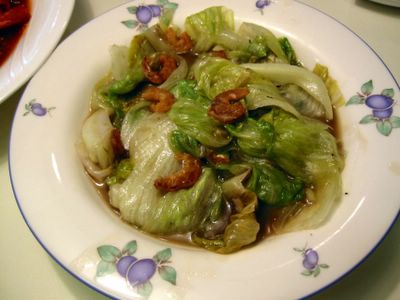 I wanted some gulay (vegetables) to go with the meat dish we have that night. But at the time our fridge was not exactly heaving with veggies in fact all we got was some leftover iceberg lettuce. I didn't want to munch on cold salad *again* so stir frying seems to be the way to go. Huang Su-Huei's Chinese Cuisine cookbook gave me the base recipe to adapt for this dish.
Stir Fried Iceberg Lettuce
I wanted some gulay (vegetables) to go with the meat dish we have that night. But at the time our fridge was not exactly heaving with veggies in fact all we got was some leftover iceberg lettuce. I didn't want to munch on cold salad *again* so stir frying seems to be the way to go. Huang Su-Huei's Chinese Cuisine cookbook gave me the base recipe to adapt for this dish.
Stir Fried Iceberg Lettuce
2 Tbsp oil
2 Tbsp dried shrimps (hibe)
1/2 tsp salt
freshly milled black pepper
1 cup stock
1 Tbsp cornstarch
1 green onion - cut into 1-inch pieces
500 g iceberg lettuce - wash and torn into large pieces
- Mix stock, salt, black pepper, cornstarch in a bowl. Set aside.
- Soak dried shrimps for 30 minutes or until soft. Drain and set aside.
- Heat oil in a wok until smoking hot. Stir fry green onions until aromatic.
- Add shrimps, cook for about half a minute; then add lettuce and cook in high heat until limp.
- Add stock mixture and cook until thick. Serve.
It never dawned on me when we decided 2 weeks ago on this month's theme of Lasang Pinoy that not only food bloggers would participate but even mother nature would seemingly display her power to set the scene. As you may know by now, several southern states in America - most especially the city of New Orleans - have been devastated by hurricane Katrina. As horrifying the news images can be, we'd like to take this opportunity to appeal for your generosity to please donate cash, blood, or otherwise to the victims of this disaster. No need to play the blame game and finger pointing right now. Let's try to help the victims of this disaster as much as we can. The Guardian has a newsblog that lists a number of charities that accepts donations. Other trusted agencies where you can make a donation are as follows:
American Red Cross or via Yahoo
British Red Cross
Catholic Relief Services
Or better yet donate in your local charities.
Now, let's get on with blogging ... this month's Lasang Pinoy theme is food you associate with typhoons, hurricanes, or storms.
 The Philippines' wet season (June-October) is synonymous with typhoons. Average of 19 of these severe storms hit the country usually originating in the vicinity of Caroline Islands in the Pacific Ocean. So many typhoons in fact, that it has been an indelible part of most Filipino's way of life. I say 'most' because not all of the whole archipelago experience the same weather at the same time. The southern region of Mindanao, for example, do not have as much typhoons as compared to the Eastern Visayas and Luzon region. A good backgrounder on the Philippines' climate and seasons can be found in Pagasa and Food and Agriculture Organization websites.
The Philippines' wet season (June-October) is synonymous with typhoons. Average of 19 of these severe storms hit the country usually originating in the vicinity of Caroline Islands in the Pacific Ocean. So many typhoons in fact, that it has been an indelible part of most Filipino's way of life. I say 'most' because not all of the whole archipelago experience the same weather at the same time. The southern region of Mindanao, for example, do not have as much typhoons as compared to the Eastern Visayas and Luzon region. A good backgrounder on the Philippines' climate and seasons can be found in Pagasa and Food and Agriculture Organization websites.
Because of the yearly deluge, Filipinos are used to adversity brought on by it so coping with natural disasters is nothing new as it gets exercised every year. The general mood after one too many in this disaster prone country is that - yes it's a tragedy, yes it's a shame on what we have lost, but life must go on and Pinoys pick up the pieces right after and try to rebuild each and everytime. No wonder one of the Pinoy's characteristics is the ability to cope with pain and hardship. And be pliant like a bamboo swaying and bending with the whatever the winds of fate brings.
 Typhoons and storms may mean high winds, deluge of rain, floods, and consequently devastation. However, it can also conjure up memories of feeling of closeness and warmth from the being cooped up inside the house, of silly games played to pass the time, of boys and girls sharing an umbrella, even of kids playing in the rain or worse(?) in the floods. And what food we had during those times! Body warming soups, hot boiled root crops, canned food, etc.
Typhoons and storms may mean high winds, deluge of rain, floods, and consequently devastation. However, it can also conjure up memories of feeling of closeness and warmth from the being cooped up inside the house, of silly games played to pass the time, of boys and girls sharing an umbrella, even of kids playing in the rain or worse(?) in the floods. And what food we had during those times! Body warming soups, hot boiled root crops, canned food, etc.
So you homework ;) now is to blog about Filipino food that you associate with typhoons, hurricanes, or storms. Try to remember what you served or have been served during a wind and rain-lashed night. Is it hot and soupy? Is it coming straight out of the can? Is it cold because there was no electricity/gas for the stove? Or maybe blog about food you have to eat to survive. Do indulge us with your 'typhoon specialties' and regale us with your stories.
Please send an email to lasang.pinoy@gmail.com with your:
Name
Blog Name & URL
Location
Blog post Permalink
on or before the 29th of September. I will be doing a round-up a few days later. If by chance you do not have a blog but wishes to participate, please email me you piece and photo (if you have one) and I will post it here. 'Hope you all will join us. :)
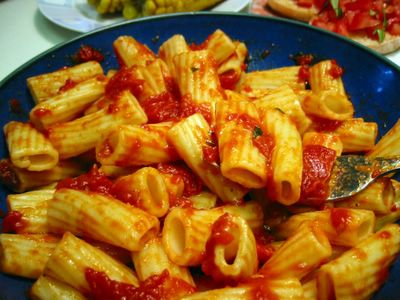 The name conjures up the meaning 'angry sauce' because of the hot chilli in it. Good way to use up tomatoes with just a little chilli - whether you use dried or fresh is alright. It's very easy, in fact, I'm discovering now a lot of these Italian pasta sauces are quite easy and fast to do. You'll just have to use fresh ingredients as much as possible to get the best flavour. Vegetarians or even vegans will like it as well with nary a sight of meat in it. A lot of Italian cookbooks advise not to serve with Parmesan cheese. I wonder why, because of the spiciness? Certainly when I had it I prefer it as it is, mopping up the sauce with some butter smeared warm crusty bread and a glass of red wine. Mmmm...
The name conjures up the meaning 'angry sauce' because of the hot chilli in it. Good way to use up tomatoes with just a little chilli - whether you use dried or fresh is alright. It's very easy, in fact, I'm discovering now a lot of these Italian pasta sauces are quite easy and fast to do. You'll just have to use fresh ingredients as much as possible to get the best flavour. Vegetarians or even vegans will like it as well with nary a sight of meat in it. A lot of Italian cookbooks advise not to serve with Parmesan cheese. I wonder why, because of the spiciness? Certainly when I had it I prefer it as it is, mopping up the sauce with some butter smeared warm crusty bread and a glass of red wine. Mmmm...
The Food of Italy cookbook provided the original material which I adapted.
Pasta Arrabbiata
1 1/2 Tbsp olive oil
1/2 Tbsp minced garlic
1 fresh birds eye chilli or 1/4 tsp dried chilli flakes (or to taste)
800 g canned chopped tomatoes or fresh tomatoes*
sea salt
2 Tbsp chopped fresh basil
500 g penne or rigatoni dried pasta
- Heat the olive oil in a saucepan or pot in low heat.
- Saute garlic and chillies until garlic is light golden brown. Keep the heat low to prevent the garlic from burning.
- Add the tomatoes and season with salt to taste.
- Simmer gently for about 30 minutes or until sauce is thick and rich.
- Meanwhile, cook the pasta according to package instructions until al dente. Drain and drizzle a little olive oil to prevent it from sticking to each other.
- Add the basil to the sauce and season again just before serving. Toss the pasta with the sauce and serve.
*Note: If using fresh tomatoes peel it first - lightly score the bottom of each tomatoes with two lines crossing each other. Blanch the tomatoes in hot water for about 30 seconds. Drain. By this time the tomatoes should be easier to peel, simply pull off skin from the bottom and all around.













